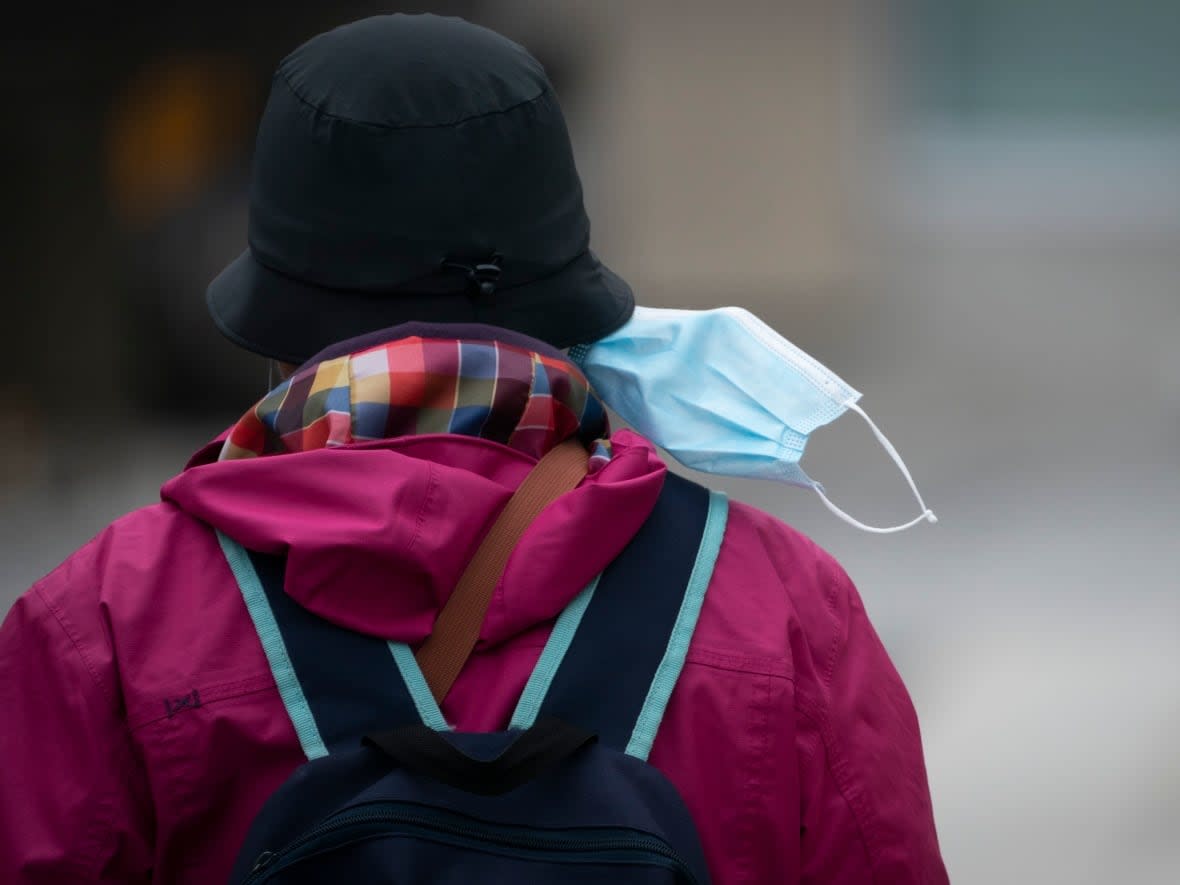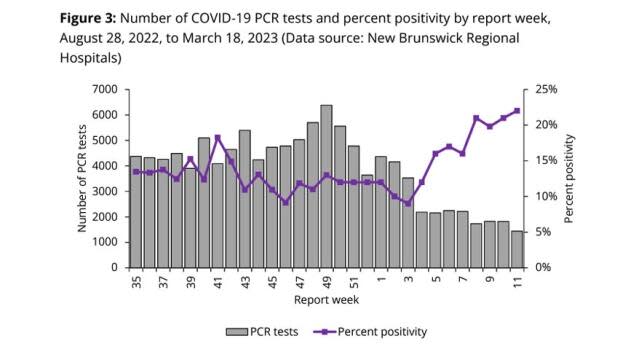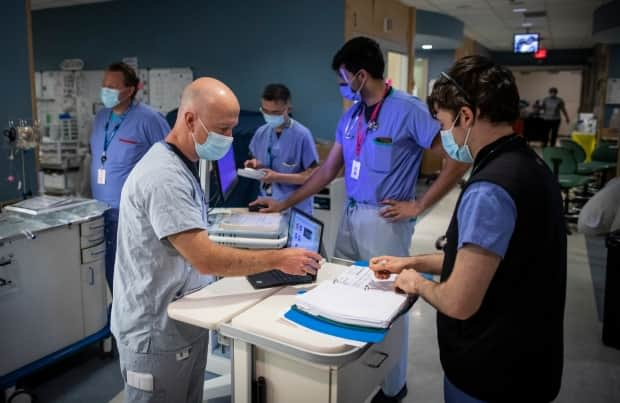N.B. adds 8 more COVID-19 deaths, test positivity rate hits nearly year-long high

New Brunswick reported eight more deaths from COVID-19 Tuesday, raising the pandemic death toll to 856, and the test positivity rate continued to climb, reaching a nearly year-long high.
Hospital admissions because of the virus, meanwhile, "remained stable" March 12 to March 18, and the number of new lab-confirmed cases decreased, the COVIDWatch report shows.
The latest results come about two weeks after March Break, when many students and their families travelled out of the province or out of the country.
Although the number of new cases has "been stable for the last several weeks, we encourage New Brunswickers to remain up to date with our latest guidance," said Department of Health spokesperson Sean Hatchard.
The department "has recommended, and continues to recommend, that everyone assess their own risk levels when determining the precautions they should use in their day-to-day lives to reduce their risks of infection," he said in an emailed statement.
CBC requested an interview with Dr. Jennifer Russell, the province's chief medical officer of health, but Hatchard said, "An interview is not possible." He did not elaborate.
CBC also asked why the department stopped posting about the weekly reports on social media last month.

Hatchard said the COVIDWatch report is posted on the government's website every Tuesday, unless a holiday or other circumstances temporarily change the routine schedule.
"At this point in the pandemic, New Brunswickers seeking the latest information on COVID-19 are familiar with where the reports are posted online, and can find them at gnb.ca/coronavirus at their convenience," he said.
Lag in reporting deaths
None of the deaths occurred during the reporting week in question. One person died earlier in March, six in February and one in January, a graphic in the report indicates.
Deaths are subject to an average two-month lag in reporting, from date of death to the registration of death, the report says.
One person was aged 50 to 69 and the other seven were all 70 or older, a comparison of data to last week's report shows.
Person under 20 among hospital admissions
Seventeen people were newly admitted to hospital because of COVID, up from 15 a week ago. Two of them require intensive care, down from three.
Among the new admissions is a person under 20, the youngest age category provided. Five are aged 20 to 59, three are 60 to 69 and eight are 70 or older.
The province no longer provides the number of people currently hospitalized, but the two regional health authorities say they have 62 people hospitalized, either for or with COVID-19, as of Saturday. That's up from 50 a week ago.
Seven people require intensive care, down from eight, Horizon and Vitalité say.
21.7% positivity
A total of 313 new cases of COVID have been confirmed through 1,442 PCR (polymerase chain reaction) lab tests, for a positivity rate of 21.7 per cent — the highest it has been since at least last April, when it was about 26 per cent.
The test positivity rate is the percentage of the total PCR lab tests performed that produced a positive result. A high test-positivity rate indicates a high level of community transmission.
Last week, the positivity rate was 21.4 per cent when 388 new cases were confirmed through 1,812 PCR tests.
CBC previously asked the Department of Health what the highest positivity rate since the beginning of the pandemic has been, and when, but the spokesperson did not answer directly.
Hatchard said it has been higher "several times in the past — most recently in early April 2022, when it hit roughly 26 per cent."
He also urged caution when comparing positivity rates at different points in the COVID-19 pandemic, "given there were different factors at play at different times — like public health mandates, different strains circulating, different testing strategies, etc."

An additional 123 people self-reported testing positive on a rapid test in the past week, down from 153, figures from the department show.
Self-reported positive rapid tests are no longer included in the weekly COVIDWatch report because they're considered "an inaccurate indicator of how many people may be positive," the province has said. They are, however, still available on the COVIDWatch landing page because they are "an indicator of virus spread and potential impact."
Of the 178 random samples sent for genetic sequencing, 55 per cent were XBB, an offshoot of the Omicron BA.2 subvariant, down from 59 per cent in last week's report.
COVIDWatch does not indicate how many of those were cases of XBB.1.5, which has been described as immune evasive and "the most transmissible" subvariant yet.
As of last week, 332 cases of XBB.1.5 have been confirmed since the subvariant was first detected in the province in January.
The breakdown of other sequenced cases includes 39 per cent Omicron subvariant BA.5, five per cent Omicron subvariant BA.2, and one per cent "other."
Most vaccination rates unchanged
A total of 447 vaccine doses were administered in the past week, including 54 first doses, 52 second doses, 67 first boosters and 274 second boosters.
First dose — 91 per cent of eligible New Brunswickers, unchanged.
Second dose — 85.9 per cent of eligible New Brunswickers, unchanged.
First booster — 54.7 per cent of eligible New Brunswickers, unchanged.
Second booster — 30.4 per cent of eligible New Brunswickers, up from 30.3 per cent.
Breakdown of hospitalizations
Horizon Health Network has 50 active COVID-19 hospital patients as of Saturday, up from 42 a week ago, its COVID dashboard shows. Three people now require intensive care, down from six.
Nearly half of the cases, 24, are in the Fredericton region, Zone 3. The Moncton region, Zone 1, has the second-highest number of cases, with 14, followed by the Miramichi region, Zone 7, with eight, and the Saint John region, Zone 2, with two.

Vitalité Health Network has 12 COVID-19 hospital patients, including four in intensive care, according to its COVID dashboard. That's up from eight and two, respectively, in last week's report.
Four of the patients are at the Dr. Georges-L.-Dumont University Hospital Centre in Moncton, Zone 1, including two in ICU. The Campbellton Regional Hospital, in Zone 5, also has four COVID patients, including one in ICU, while the Chaleur Regional Hospital in the Bathurst region, Zone 6, has three patients and the Edmundston Regional Hospital in Zone 4, has one who is in intensive care.
Infected Horizon employees jumps nearly 85%
The number of health-care workers off the job across the province after testing positive for COVID-19 has jumped to 83, after last week's decrease to 57 from 78.
Horizon saw the biggest increase with 48 infected employees absent, up from 26 — a rise of nearly 85 per cent.
Vitalité reports 35 positive staff, up nearly 13 per cent from the 31 absences in last week's report.
There are COVID-19 outbreaks on two Horizon hospital units, the same number as the previous week. No specifics are provided, but the Moncton and Miramichi regions each have one, the dashboard shows.
Vitalité has not updated its COVID outbreak page. It still lists one outbreak at the Restigouche Hospital Centre's continuous rehabilitation unit, as of March 10.


